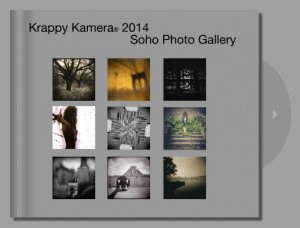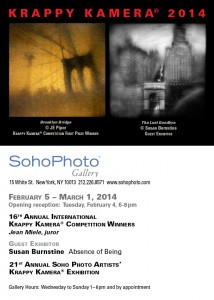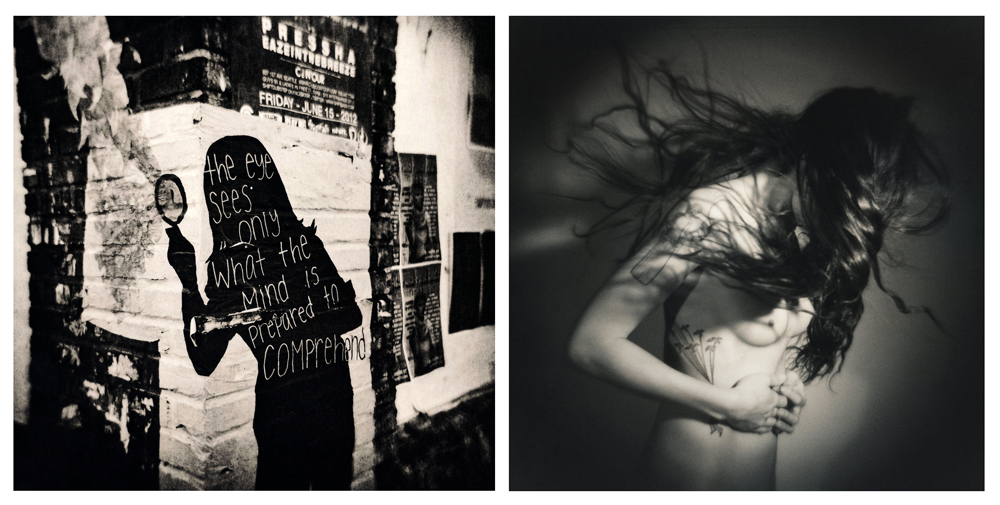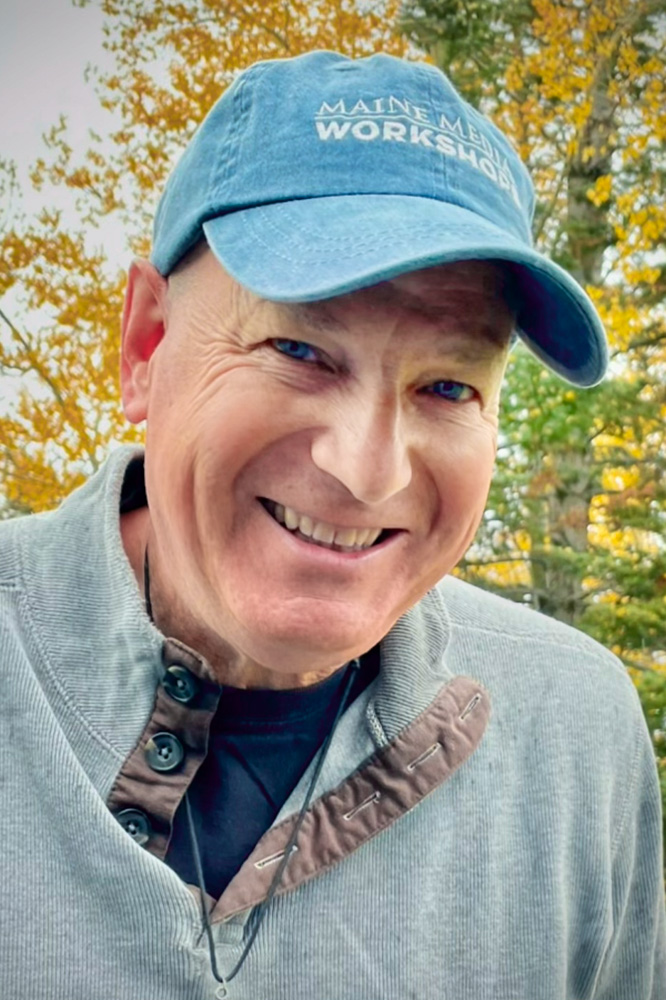What if?
I read somewhere that one of the guys who worked on the original Adobe Photoshop team thought that his greatest contribution to the program was managing to convince the others to include “Command-Z.” He said that “undo” was really “what if?”
Think about that. A keyboard shortcut for possibility. “What if?” is the impulse behind the Krappy Kamera show. “What if?” is at the heart of creativity. “What if?” pushes the limits of expectation, and makes surprise an integral part of the darkroom formula. It makes room for possibilities that are better than what you can plan for – or even imagine.
After all, if we have a vision, and we execute that vision to perfection, that’s great. But that also means our vision can’t ever go any further than what we saw in our head in the first place. That’s pretty limiting, if you think about it. On the other hand, what if you let go of some control? (Pretty tough for photographers.) What if you allow the universe a hand in the process? What if your camera has light leaks, or you add kerosene to the developer, or if (heaven forbid, you maniacal film devotees!) you cobble a fifty-cent lens onto your $3000 dslr?
What if? The answers are the remarkable pictures in this exhibition, each the result of a beautiful balance between intentionality and surrender. The answer to “What if?” is that you create a little bit of room for magic to happen.
– Jean Miele, January 2014
Even though I was the sole juror for the 2014 International Krappy Kamera competition, I was in no way involved in the process of hanging the exhibition. I judged the show online, in the comfort and solitude of my studio. (And there were hundreds of entries, submitted from all over the US, and six different countries.) So when I had the pleasure of seeing the exhibition on the walls for the first time at the opening reception, it was a revelation! Viewing images on a monitor – even a calibrated monitor – means they’re changeable. The size isn’t fixed. The texture is the texture of the screen. They’re stripped down and minimal – without mats or frames.
All the photographs I had the honor of selecting were strong in their own right. Once they were on the wall, though, I got to see the work just exactly the way the creators wanted it to be seen. When a photographer makes a print, they’re sharing the nuances of their vision with you: by deciding just what size you should see the print; by choosing whether it’s small, floated in an oversize mat, or printed as an oversize, borderless presentation. Each artist selects from a vast array of different paper surfaces and textures… all to suit their vision for that particular image. The choices a photographer makes as they decide how to print and present their work is akin to the way a master chef carefully chooses a palette of ingredients and spices for each particular dish, and meticulously prepares and plates it. Every print in this show is cooked up as uniquely as the individual photographers themselves.

Krappy Kamera® 2014 Book – available through Blurb. This book contains all 46 winning images that comprised the exhibition at Soho Photo. Click on thumbnail to preview and purchase book. Or scroll down to the gallery below to see all winning entries.
Every single photograph in this year’s exhibition is perfectly beautiful by itself – each an expression as unique as the photographer who created it. And, the whole being greater than its parts – gathered together on the walls of Soho Photo they begin to resonate with each other, to form a poem, or a song. And even though the subject matter seems inconsistent, nothing could be further from the truth. There is a clear theme that binds this work together. I’d be lying to you if I told you I was conscious of this thread as I made my selections. But seeing the show hung on the walls, it was clear to me that every one of these images was an expression of our collective longing for the divine. These images are a photographic celebration of life and consciousness. Every artist feeling and responding to the invisible draw of something greater than ourselves, as naturally as flowers reach for the sun.
Of course, Susan Burnstine‘s work, presented as the Guest Show in the adjacent gallery, adds a whole other dimension to the exhibition overall, and provides yet another reason to see the show in person.
My thanks to all who were involved. What a pleasure.
You’ve got until March 1, 2014 to see the show on the walls.
Meanwhile, or in case New York isn’t geographically convenient, here’s a gallery with the whole exhibition:
More about the Exhibition, the Opening Reception, and the History of Krappy Kamera…
The opening reception for the 2014 Krappy Kamera Exhibition at Soho Photo was wonderfully well-attended, perhaps in part due to the mention we received that morning on the New York Times’ blog: “Winners of the Krappy Kamera Competition, celebrating degraded equipment, degraded processing chemicals and degraded images, go on display at SohoPhoto on White Street. Opening at 6 p.m. [Free]” Thank you, NYT for the mention. I’m sure it added substantially to the crowd! And while I agree that the lenses may be, I respectfully take exception to your characterization of the images as “degraded.” They’re sublime.
And the exhibition could not have been mounted more beautifully. Some of my favorite images from the show were by Eddie Wexler, Marky Kauffman, Robert Schneider, and I thought the pairing below was noteworthy, because I just loved the way the images complemented each other.
Thanks and kudos to Myra Hafetz, who had the monumental ask of coordinating the whole contest, Lynn Passy, who has taken on the cat-herding mantle of Soho Photo President, Larry Davis, Diane Zeitlin, Irene Greenberg, Silvia Marinari, and all the other Soho Photo members.
These two images, “Mind’s Eye” by Brian Gliniak, and “Jacs (3)” by William Vrachopolous, respectively, were hung on the wall next to each other. I love the way each mirrors the other.
A few pictures from the opening reception:
The winners of this year’s competition are:
1st Place: JE Piper, New York, NY
2nd Place: Matthew Cetta, Demarest, NJ
3rd Place: David Cory, South Bend, IN
Holga Inspire Award: Gary Geboy, Beaufort, SC
Soho Photo People’s Choice Award: Mindaugas Gabrenas, NY
Finally, info from the Soho Photo website, the press release – and a little history.
New York, NY. Soho Photo Gallery of NYC is pleased to announce its 16th annual International Krappy Kamera juried competition. This year’s juror is photographer,artist & educator, Mr. Jean Miele. All chosen photographs will be displayed in a group exhibition at the gallery February 5 – March 1, 2014, which will feature the winning entries, as well as a guest exhibition by Susan Burnstine.
The 2014 Krappy Kamera Competition presents winning images from photographers across the United States and, this year, from Italy, Greece, Canada, Poland and Lithuania. All submitted images were made using plastic cameras such as Holgas, Dianas, and Anscos, cameras with a pinhole body cap or a Holga-type lens, or something similar.
About the Competition
Our philosophy at Soho Photo: In the hands of an artist, great photographs can be made with basic equipment. To explore this talent, we are searching for extraordinary photographs made with lousy lenses. Artists are encouraged to explore this medium and let the creative juices flow while shooting and in the darkroom (wet or digital). Remember, it’s the Krappy Kamera Competition – not the Krappy Print Competition.
What is a Krappy Kamera? Examples of some Krappy cameras are the Holga, Diana, Ansco, and pinhole cameras. You can also create your own Krappy Kamera by using your non-Krappy camera (e.g. 4×5, SLR, DSLR) and exchanging the lens with a Krappy Lens (e.g. pinhole body cap or Holga-type lens). Cell phones, disposables and point-and-shoot cameras are ineligible. Remember, just because a camera is old and moldy doesn’t make it Krappy. The lens is the determining factor.
If you’re interested in the origins of the Krappy Kamera Show, here’s an excerpt from an interview with Sandy Carrion, who along with Mary Ann Lynch, organized the first National Krappy Kamera® Competition.
“The concept was born at the Soho Photo Gallery (www.sohophoto.com) in New York during a reception. One of the members, Allan Schill, was exhibiting works made using a pinhole camera. As the evening progressed, a third member, Alan Bassett, joined us. We all admitted to preferring our junky cameras to our high-end stuff, and I proposed we organize an exhibit opportunity for other gallery members. That was 15 years ago, and we’ve held the members’ Krappy Kamera exhibition every year. The name was just something I always used to distinguish between my ‘good’ and ‘not-so-good’ cameras. I added the Ks to make it funnier. We received so much publicity that it sort of took off on its own. People from all over started to call me asking how they could be involved.”
Mark your calendars, and get busy shooting! We’re looking forward to seeing your entries next year! 🙂



































































Jean, What a great tribute to the beautiful show you selected. Your enthusiasm and love of photography is obvious in everything you do. Thanks again for being such a wonderful juror and friend of the Krap Kommunity.
Jean, your comments about the show are much appreciated. I think you have articulated perfectly the spirit of what we lo-fi photographers try to do.
David Cory
Thanks, David. I think your work is wonderful. In fact, at the opening, I was moved to take one of your pieces from the wall, and share with the crowd how I saw beautiful parallels between your Rotomator pieces and Tibetan mandalas. I was also extremely happy to find the picture you posted on Flickr of your Rotomator, and your explanation of how it works! 🙂 Genius.
And here’s a lovely interview with JE Piper, by Norman Borden. Worth reading. And looking at the pictures 😉 (of JE’s camera):
http://myemail.constantcontact.com/Krappy-Kamera-1st-prize-winner-tells-all—show-closes-Mar-1–.html?soid=1102433539713&aid=GH9wAzgJ9jU
A wonderful selection of images, Jean. I enjoyed reading your essay also. Together, I hope they inspire more people to think along the lines of “what if” and pick up some of these plastic wonders. Sadly, I didn’t make it to New York this year to see the show, but the online exhibition suggests that I was in good company. Thanks for your efforts!